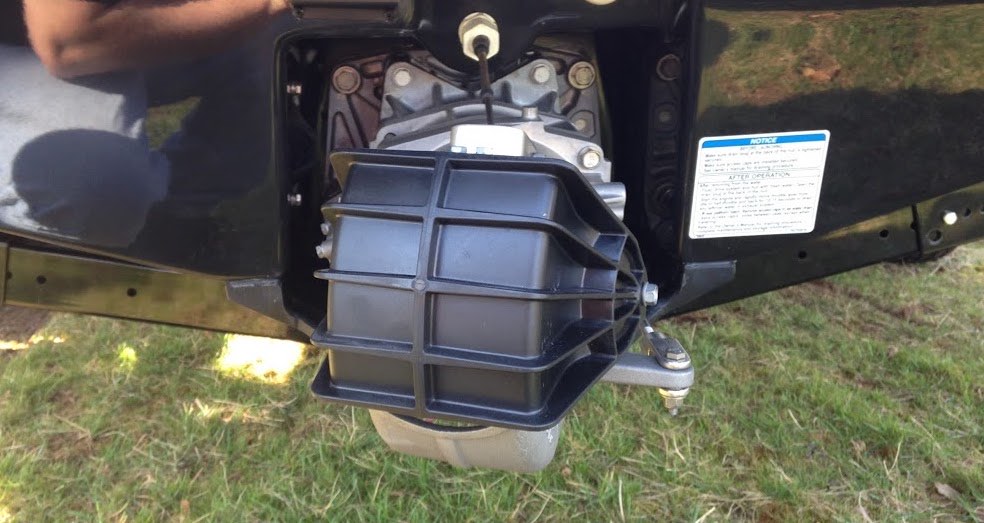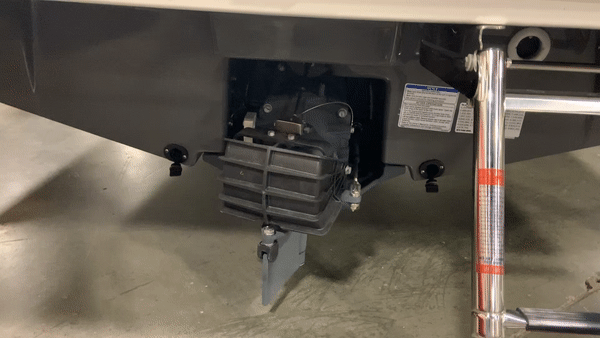Do jet boats have reverse?
Yes, jet boats have reverse.
Do jet boats have neutral?
Yes, you could say jet boats have neutral, but I need to explain that more.
Both reverse and neutral on a jet boat are very different from other boats; some could say it’s better.
How Jet Drives Work on a Jet Boat
Before we can talk about reverse and neutral, we need to talk about the drive system on a jet boat.
A regular boat will have a transmission that slips into and out of gears. These gears are forward, neutral, and reverse.
When it comes to jet boats they don’t have transmissions, yet they still have reverse and “neutral.” I put “neutral” in quotes for a good reason; I’ll explain that later.
To control forward and reverse direction a jet boat uses what is essentially a bucket. This bucket directs where the water should flow.


Pictured above is an example of this bucket from Yamaha Jet Boats. This one works in a clamshell-style. Right now the bucket is in reverse as the top black and bottom metal of the bucket is blocking the direction of the water thus putting the boat in reverse. The water is being directed down and to the front. To go forward the bucket opens up and the water goes to the rear pushing the boat forward. Moving this bucket or nozzle left or right controls your steering. It’s quite a simple system once you see it, far easier to deal with than other boats.
If there is no transmission and a bucket controls forward and reverse, how does neutral work?
How Neutral on a Jet Boat Works
The way neutral works on a jet boat is super simple – it’s the spot between forward and reverse.
This is precisely how jet skis work too. A bucket controls forward, neutral, and reverse. In fact, jet boats are just bigger jet skis. They even share the same engine with some jet boats having twin jet ski engines.
Important: When the engine is on, the impeller is spinning. As a safety measure, it’s important to keep this in mind when boarding and getting off a jet boat. In other words, turn the engine off when someone is near the rear of a jet boat or any boat for that matter.
Many manufacturers like Scarab allow some of their jet boats neutral to be fine-tune because they use an electric motor to move the bucket up and down.
Keep this in mind when starting a jet boat; it may move an inch or two forward when you start it. I don’t want to freak you out; most people don’t even notice as the manufacturer does a great job of putting the bucket just right. The wind and waves will move you more than neutral, so it’s not a big issue.
If it’s moving more than that, you need to either adjust it via the control system or let the dealership know. This is something a dealership should check before taking delivery. A slight movement is okay, but not too much.
Jet Boats Have Reverse
As stated before, jet boats do have reverse. What controls reverse is a bucket in the rear that directs the water in the opposite direction so you can go in reverse.
And neutral is a spot between forward and neutral, they cancel each other out.
Since this system is so different than a typical boat, it brings up a new question.
Is It Hard to Drive a Jet Boat?
No, it’s not hard to drive a jet boat.
If you ask me, it’s easier.
With a regular boat, you need to make quick and confident movements with the forward, neutral, or reverse lever. You need the gears not to hang or slip. You also need to move the steering wheel a lot more as you have to move heavier and bigger outdrives.
With a jet boat, you’re only moving a single nozzle that weighs about as much as your phone. Since the nozzle is already small, you don’t need to move it much, so the steering on a jet boat is shorter.
Think of the steering on a jet boat more like a sports car. Super tight and short. If anything, how much you steer a jet boat is more in line with the travel you see in a car. With a regular boat, you’ll have to do a lot more rotations of the steering wheel to get the same movement.
As for shifting, you need to be more gentle and fluid. Instead of being fast and confident like with a regular boat.
When it comes to jet boats, slow and steady always wins.
Any fast movements on a jet boat will mean you’ll bang into the dock.
Since you have much more fine-grain controls on a jet boat, you have more precision.
This precision becomes evident when you realize you can steer in neutral. You can’t steer in neutral on a regular boat but with a jet boat, you can. This means you can turn on a dime and put a jet boat where ever you want. Because you can steer in neutral you end up with more control on a jet boat than any other boat.
Over the weeks you can quickly master this and show off. I was able to do this, and many people find it impressive that I can dock a jet boat backward into a slip. Just remember slow and steady wins.
If you have driven regular boats all your life, this change in driving will have a different learning curve. If you never owned any boat, you’ll find the driving style of jet boats easier to get used to. A jet boat handles more like a car than a regular boat. You don’t spin the steering wheel much in a car, but a regular boat it could be 3 or more full rotations to get where you need to be. I find I have an easier time teaching people to drive jet boats especially when they’re new to boating.
Just remember, slow and steady!
Idle Speed of a Jet Boat
I need to make a note about the idle speed of a jet boat. Just like jet skis, a jet boat idles higher than a regular boat.
Some no-wake areas and clubs have stringent rules about speed. They want you to be under 4 mph, this is easy to do in a jet boat.
With a jet boat, you’ll find two types of throttle controls. Either a dual system with one being the one for forward, neutral, and reverse and the other for throttle. You’ll also have the more traditional option that you see in other boats that is just one lever that does both throttle and drive.
Either drive system is the same; it’s more preference than anything. From my personal experience, both are fine and don’t matter.
To control the idle speed, you push the manual release button on the lever in and slightly push the lever forward. You don’t need much; you just need the bucket less in the neutral spot. Since there are so many variations of jet boats it’s best to consult your owners manual about idle speed and no-wake areas.
You’ll find many manufacturers like Yamaha and Scarab allowing you to adjust idle speed or no-wake speed.
I have to make a note of this because of all the time people yell at me in the no-wake zones. I’m at idle speed, but it looks like I’m going faster because of how a jet boat output sprays more water, which makes it seem like I have a wake when I don’t. The rule is no throttle and idle in the no-wake zone, but I like to go slower than my normal idle speed. Not to please the always angry people but to have even more control of the boat. Remember, slow and steady wins when it comes to jet boats.
Anything Else?
When it comes to jet drives, you might be wondering if there is anything else you should know about them in comparison to other boats.
There is one huge point about jet drives that you need to understand – they’re super powerful vacuums.
This means they can and will suck up anything near them.
When boarding or getting off a jet boat, you need to have the engine off. Even though there is no exposed prop, it’s still dangerous to be near the rear with the engine on.
Also, you need to be more aware of shallow areas. Yes, there is no exposed prop to get caught on something, but if you go shallow enough, the jet boat could suck up sand and rocks. This can stop the engine and damage things like a wear ring or impeller.
You also need to be aware of the ropes you have. Tow ropes or dock lines can easily get sucked up by any boat, but even more so on a jet boat. It’s best to use a shock tube if you do pull sports or get a wake tower for your boat.
Some manufacturers have gotten smart about this sucking up rope problem. Scarab has a metal sleeve around the drive shaft making sucking up ropes and getting stuck around the driveshaft not very common. You can still suck up ropes, but it’s easier to deal with.
Yamaha jet boats even have a cleanout port on some of their boats to make cleaning out weeds and ropes easier.
Weeds, rope, and shallow water are the enemy of jet boats. It’s still better than damaging a whole outdrive on a regular boat; those suckers are far more expensive to fix than any jet boat problems. Weeds and rope can affect any boat; it’s just something to keep in mind with all of them.
very good info thank you